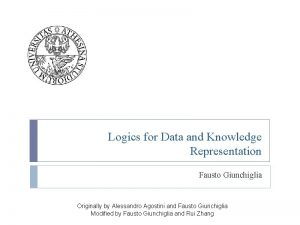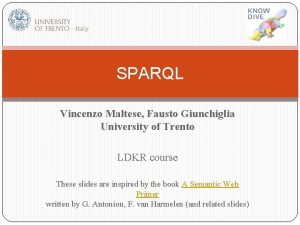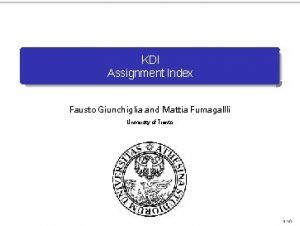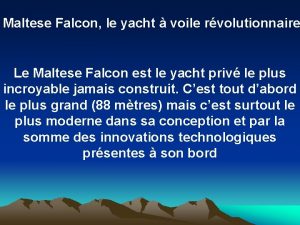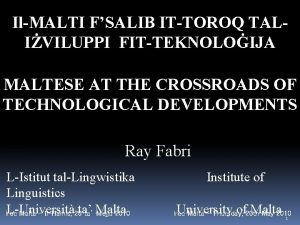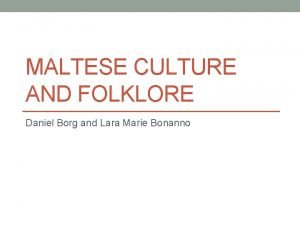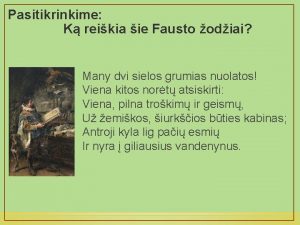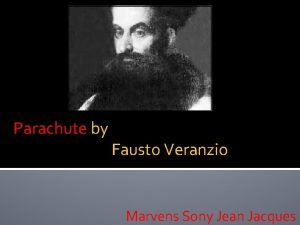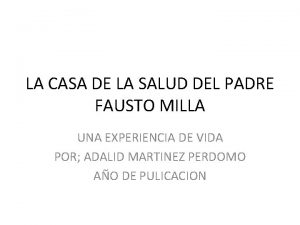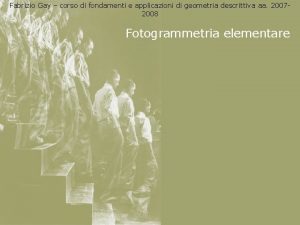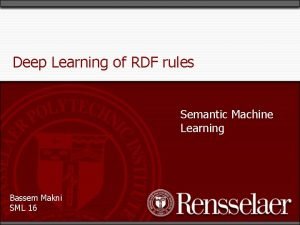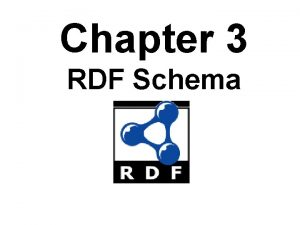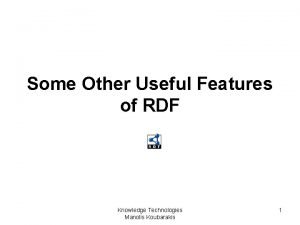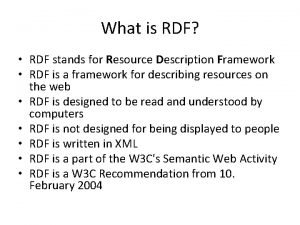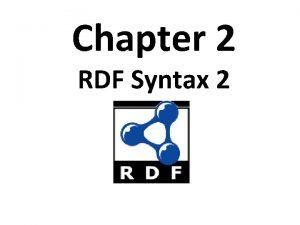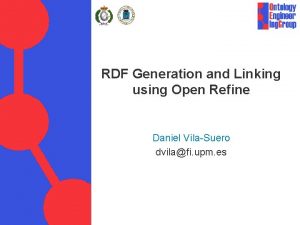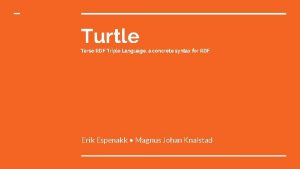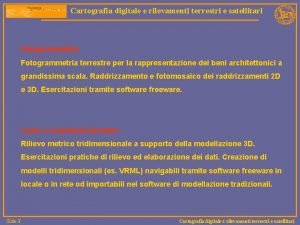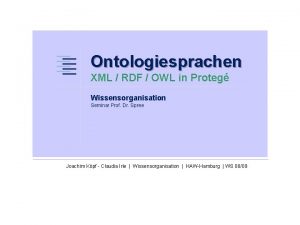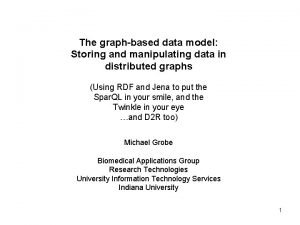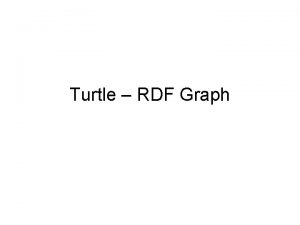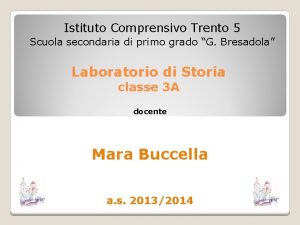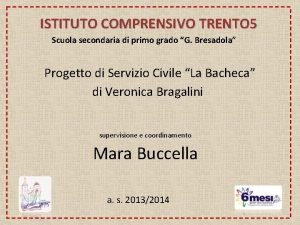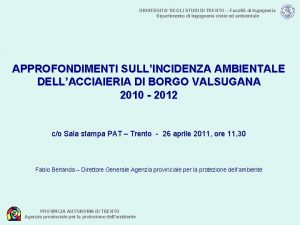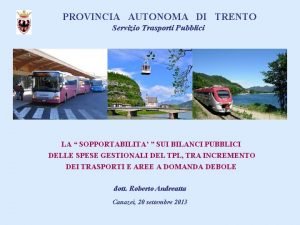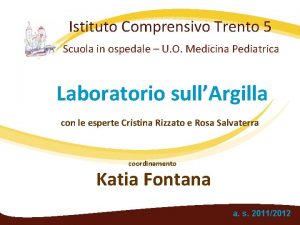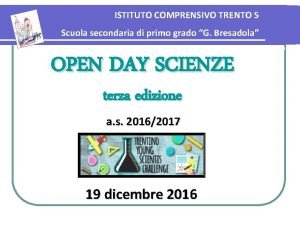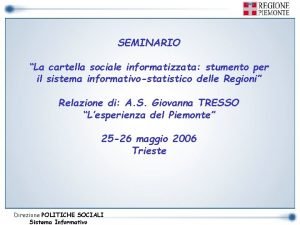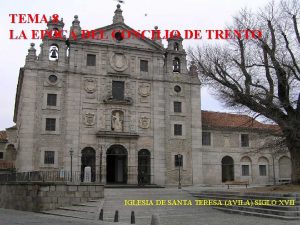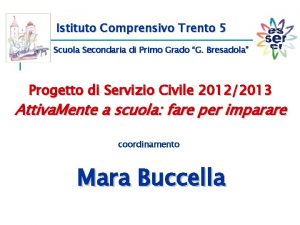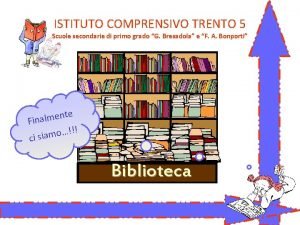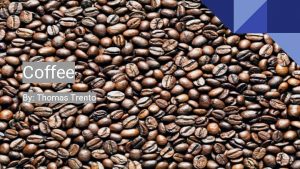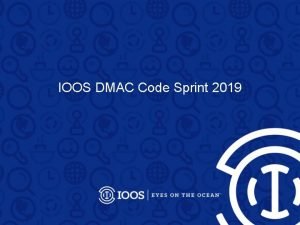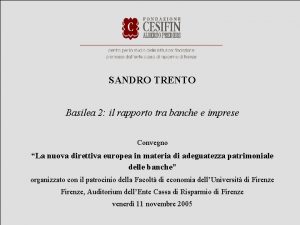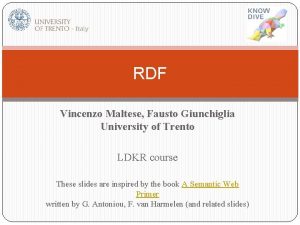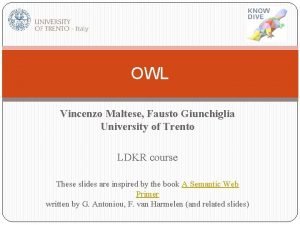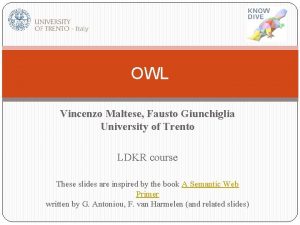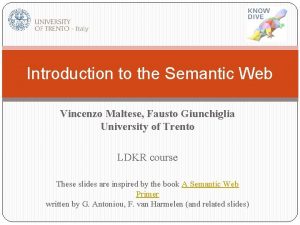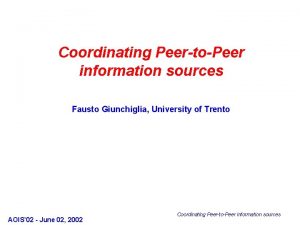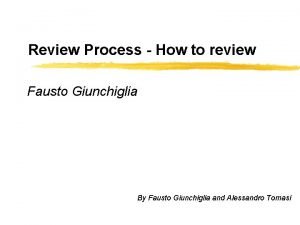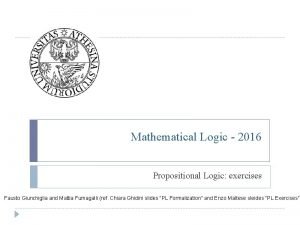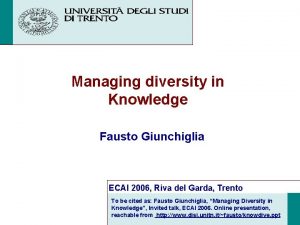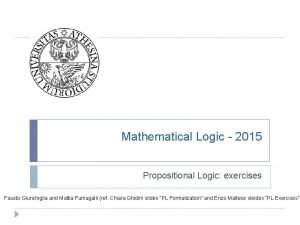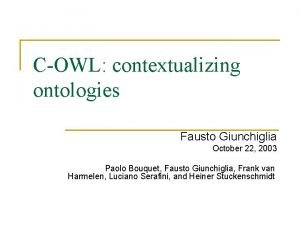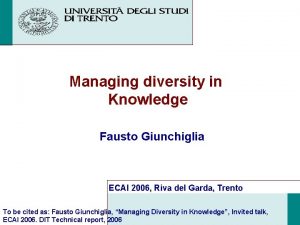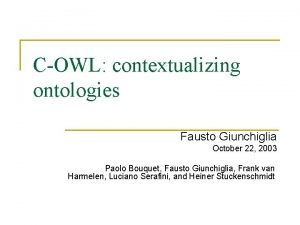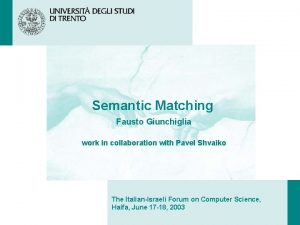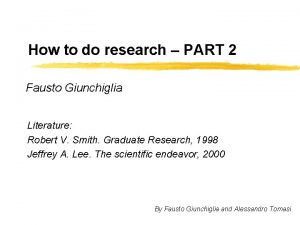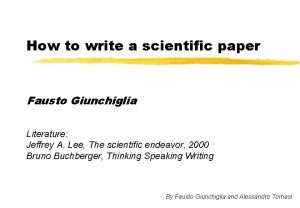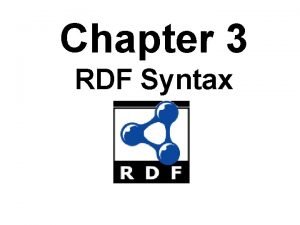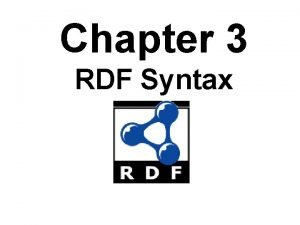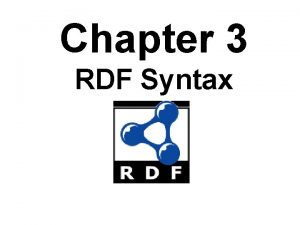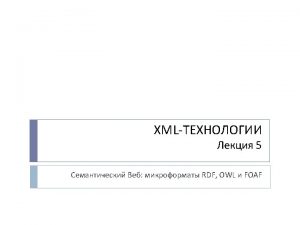RDF Vincenzo Maltese Fausto Giunchiglia University of Trento





















































- Slides: 53

RDF Vincenzo Maltese, Fausto Giunchiglia University of Trento LDKR course These slides are inspired by the book A Semantic Web Primer written by G. Antoniou, F. van Harmelen (and related slides)

Roadmap XML From HTML to XML Similarities and differences XML features and limits RDF Syntax Language and data model Reification Containers and collections Semantics RDF schema Reasoning Inference system Inference rules Exercises 2

XML 3 Chapter 1

HTML vs. XML HTML: focus on presentation <h 2>The adventures of Tom Sawyer</h 2> … <b>Author: </b> Mark Twain <b>Cover artist: </b> created by <a href=“http: //…”>Mark Twain </a> … XML: focus on metadata <book> <title> The adventures of Tom Sawyer </title> <author> Mark Twain </author> <genre> Bildungsroman </genre> <genre> picaresque </genre> … <publisher> American Publishing Company </publisher> <year>1876</year> </book> 4

HTML vs. XML: similarities and differences Similarities They both use of tags Tags may be nested Humans can read and interpret both HTML and XML quite easily Machines can read and interpret only to some extent Differences HTML is to tell machines about how to interpret formatting for graphical presentation XML is to tell machines about metadata content and relationships between different pieces of information XML allows the definition of constraints on values HTML tags are fixed, while XML tags are user defined 5

More about XML meta markup language: language for defining markup languages Query languages for XML: Xquery XQL XML-QLs Style sheets can be written in various languages to define how to present XML to humans: CSS 2 (cascading style sheets level 2) XSL (extensible stylesheet language) Transformations: XSLT specifies rules to transform an XML document to: another XML document an HTML document plain text 6

XML in a nutshell XML features: A metalanguage that allows users to define markup It separates content and structure from formatting It is the de facto standard for the representation and exchange of structured information on the Web It is supported by query languages XML limits: The semantics of XML documents is not accessible to machines The nesting of tags does not have standard meaning Interoperability is possible if there is a shared understanding of the vocabulary 7

RDF 8 Chapter 1

RDF and the Semantic Web RDF (Resource Description Framework) is at the basis of the Semantic Web Definitions A language for representing Web resources and information about them in the form of metadata [RDF Primer] A language to represent all kinds of things that can be identified on the Web [RDF Primer] A domain independent data model for representing information on the Web [G. Antoniou and F. van Harmelen, 2004] A language with an underlying model designed to publish data on the Semantic Web [F. Giunchiglia et al. , 2010] 9

Distributing Data Across the Web WORKS SUBJECTS ID Title Author Medium Year 1 Hamlet Shakespeare Play 1599 2 Othello Shakespeare Play 1604 3 Edward II C. Marlowe Play 1592 4 Hero and Leander C. Marlowe Poem 1593 VALUE PROPERTIES Data Distribution (over many machines where each machine maintains a part) row by row column by column cell by cell (the strategy taken by RDF): a global identifier for the column headings a global identifier for the row headings a global identifier for non-literal values 10

RDF syntax 11 Chapter 1

RDF language and data model RDF language A language for representing data in the Semantic Web A language for expressing simple statements of the form subjectproperty-value (binary predicates) The capability to perform inference on statements RDF data model The data model in RDF is a graph data model An edge with two connecting nodes forms a triple subject property value 12

RDF language Formal syntax: RDF has been given a syntax in XML and inherits all its benefits Statements in RDF are machine comprehensible Resources: An object, an entity or anything we want to talk about (e. g. authors, books, publishers, places, people, facilities) Properties: They codify relations (e. g. written-by, friend-of, located-in, …) and attributes (e. g. age, date of birth, length …) Statements: Statements assert the properties of resources in form of triples subjectproperty-value Every resource and property has a URI (an URL or any other identifier) 13 Values can be resources (for relations) or literals (for attributes)

RDF data model http: //www. geonames. org RELATION http: //www. geonames. org/countries http: //purl. org/dc/terms/coverage resource http: //www. geonames. org ATTRIBUTE September 25, 2015 http: //purl. org/dc/terms/modified resource literal 14

RDF as graph http: //www. geonames. org/countries http: //purl. org/dc/terms/coverage resource htt p: / /pu rl. o rg/ dc/ t erm s/m od ifie d September 25, 2015 literal 15

XML syntax example <? xml version=“ 1. 0”? > <rdf: RDF xmlns: rdf="http: //www. w 3. org/1999/02/22 -rdf-syntax-ns#" xmlns: rdfs="http: //www. w 3. org/2000/01/rdf-schema#" xmlns: dc="http: //purl. org/dc/terms#"> <rdf: Description rdf: about="http: //www. geonames. org"> <rdfs: label>Geo. Names</rdfs: label> <dc: coverage rdf: resource="http: //www. geonames. org/countries"/> <dc: modified>September 25, 2015</dc: modified> </rdf: Description> </rdf: RDF> 16

RDF/XML elements <? xml version=“ 1. 0”? > <rdf: RDF xmlns: rdf="http: //www. w 3. org/1999/02/22 -rdf-syntax-ns#" NAMESPACES xmlns: xsd="http: //www. w 3. org/2001/XMLSchema#" xmlns: uni="http: //www. mydomain. org/uni-ns"> URI or fragment of it RESOURCE HAS BEEN DEFINED ELSEWHERE <rdf: Description rdf: about=“CIT 1111”> VALUE <uni: course. Name>Discrete Matematics</uni: course. Name> RELATION <uni: is. Taught. By rdf: resource=“#949318”> ATTRIBUTE <uni: age rdf: datatype="&xsd: integer">27<uni: age> </rdf: Description> DATA TYPE <rdf: Description rdf: ID=“#949318"> RESOURCE IS DEFINED HERE <uni: name>David Billington</uni: name> <uni: title>Associate Professor</uni: title> <uni: age rdf: datatype="&xsd: integer">27<uni: age> </rdf: Description> </rdf: RDF> 17

RDF typing <rdf: Description rdf: ID="CIT 1111"> <rdf: type rdf: resource="http: //www. mydomain. org/unins#course"/> <uni: course. Name>Discrete Maths</uni: course. Name> <uni: is. Taught. By rdf: resource="#949318"/> </rdf: Description> <rdf: Description rdf: ID="949318"> <rdf: type rdf: resource="http: //www. mydomain. org/unins#lecturer"/> <uni: name>David Billington</uni: name> <uni: title>Associate Professor</uni: title> </rdf: Description> 18

RDF Reification can be used to represent: Generic statements about statements Structured attributes (e. g. address) Units of measure Provenance information Time validity and other contextual information capital Rome statement#12345 start. Date end. Date 27 BC 476 AD Roman Empire 19

RDF Reification: example the following RDF represents the fact that “the item 10245 has weight 2. 4 (in some measuring unit, e. g. , in kg)” and “the staff with id 85740 has written this statement” <? xml version="1. 0"? > <!DOCTYPE rdf: RDF [<!ENTITY xsd "http: //www. w 3. org/2001/XMLSchema#">]> <rdf: RDF xmlns: rdf="http: //www. w 3. org/1999/02/22 -rdf-syntax-ns#" xmlns: dc="http: //purl. org/dc/elements/1. 1/" xmlns: exterms="http: //www. example. com/terms/" xml: base="http: //www. example. com/2002/04/products"> <rdf: Description rdf: ID="item 10245"> <exterms: weight rdf: datatype="&xsd; decimal">2. 4</exterms: weight> </rdf: Description> Below the URI triple 12345 is used to identify the original statement provided above <rdf: Statement rdf: about="#triple 12345"> <rdf: subject rdf: resource="http: //www. example. com/2002/04/products#item 10245"/> <rdf: predicate rdf: resource="http: //www. example. com/terms/weight"/> <rdf: object rdf: datatype="&xsd; decimal">2. 4</rdf: object> <dc: creator rdf: resource="http: //www. example. com/staffid/85740"/> </rdf: Statement> </rdf: RDF>

Containers collect a number of resources or attributes about which we want to make statements as a whole: rdf: Bag an unordered container (e. g. members of a group, documents in a folder) rdf: Seq an ordered container (e. g. modules of a course, items on an agenda, an alphabetized list of staff members) rdf: Alt a set of alternatives (e. g. the document home and mirrors, translations of a document in various languages) Members are listed using rdf: li or by rdf: _1, rdf: _2 … Containers are open lists of members, i. e. we cannot exclude the existence of other members 21

Examples (in compact representation) <uni: lecturer rdf: ID="949352" uni: name="Grigoris Antoniou" uni: title="Professor"> <uni: courses. Taught> <rdf: Bag rdf: ID="DBcourses"> <rdf: _1 rdf: resource="#CIT 1112"/> <rdf: _2 rdf: resource="#CIT 3116"/> </rdf: Bag> </uni: courses. Taught> </uni: lecturer> <uni: course rdf: ID="CIT 1111" uni: course. Name="Discrete Mathematics"> <uni: lecturer> <rdf: Alt> <rdf: li rdf: resource="#949352"/> <rdf: li rdf: resource="#949318"/> </rdf: Alt> </uni: lecturer> </uni: course> 22

Collections can represent a close list of members overcoming the limitation of Containers Example: a collection with exactly 3 members: <rdf: Description rdf: about="#CIT 2112"> <uni: is. Taught. By rdf: parse. Type="Collection"> <rdf: Description rdf: about="#949111"/> <rdf: Description rdf: about="#949352"/> <rdf: Description rdf: about="#949318"/> </uni: is. Taught. By> </rdf: Description> 23

RDF semantics 24 Chapter 1

RDF schema RDF is a universal language that lets users describe resources in their own vocabularies RDF by default does not assume, nor defines semantics of any particular application domain RDF schema A language defined to provide mechanisms to add semantics to RDF resources, in terms of: Classes (rdfs: Class) and Properties (rdfs: Property) Class Hierarchies and Inheritance (rdfs: sub. Class. Of) Property Hierarchies (rdfs: sub. Property. Of) Domain (rdfs: domain) and range (rdfs: range) of properties It is similar to the object-oriented programming (OOP) paradigm with the difference that in OOP the central notion is the class (and properties are defined for them), while in RDF the central notion is the property and classes are used to specify their domain/range. Classes and instances Individual objects that belong to a class are referred to as instances of that 25

Graphical example 26

RDF example <rdfs: Class rdf: about="#accademic. Staff. Member"> <rdfs: sub. Class. Of rdf: resource="#staff. Member"/> </rdfs: Class> <rdf: Property rdf: ID="phone"> <rdfs: domain rdf: resource="#staff. Member"/> <rdfs: range rdf: resource="http: //www. w 3. org/2000/01/rdfschema#Literal"/> </rdf: Property> … 27

Utility properties rdfs: see. Also relates a resource to another resource that explains it rdfs: is. Defined. By is a subproperty of rdfs: see. Also and relates a resource to the place where its definition, typically an RDF schema, is found rdfs: comment support comments that can be associated with a resource rdfs: label is a human-friendly name associated with a resource <rdfs: Class rdf: ID="course"> <rdfs: comment>The class of courses</rdfs: comment> </rdfs: Class> <rdf: Property rdf: ID="is. Taught. By"> <rdfs: comment> Inherits domain ("course") and range ("lecturer") from its superproperty "involves" </rdfs: comment> <rdfs: sub. Property. Of rdf: resource="#involves"/> </rdf: Property> 28

Reasoning 29 Chapter 1

Inference system Sound and complete set of inference rules: The RDF inference system consists of inference rules Sound: inference rules prove only formulas that are valid with respect to its semantics Complete: every formula having a certain property can be derived via the inference system Examples of rules: (transitivity) IF E contains the triples (? u, rdfs: sub. Class. Of, ? v) and (? v, rdfs: subclass. Of, ? w) THEN E also contains the triple (? u, rdfs: sub. Class. Of, ? w) (inheritance) IF E contains the triples (? x, rdf: type, ? u) and (? u, rdfs: sub. Class. Of, ? v) THEN E also contains the triple (? x, rdf: type, ? v) 30

RDF Inferencing by example Type (rdf: type) propagation through rdfs: sub. Class. Of : Fausto Giunchiglia rdf: type : Professor rdfs: sub. Class. Of : Faculty : Fausto Giunchiglia rdf: type : Faculty (inferred) Relationship propagation through rdfs: sub. Propert. Of : professorship. At rdfs: sub. Properyt. Of : affiliation. With : Fausto Giunchiglia : professorship. At : Uni. TN : Fausto Giunchiglia : affiliation. With : Uni. TN (inferred) Type identification through rdfs: domain : professorship. At rdfs: domain : Person : Fausto Giunchiglia : professorship. At : Uni. Tn : Fausto Giunchiglia rdf: type : Person (inferred) 31

RDF Inferencing by example Type identification through rdfs: range : professorship. At rdfs: range : Educational_Institution : Fausto_Giunchiglia : professrship. At : Uni. Tn rdf: type : Educational_Institution (inferred) Inferencing through rdfs: domain and rdfs: sub. Class. Of : Researcher rdfs: sub. Class. Of : Scientist : h. Index rdfs: domain : Researcher : Fausto Giunchiglia : h. Index 48 : Fausto Giunchiglia rdf: type : Researcher (inferred) : Fausto Giunchiglia rdf: type : Scientist (inferred) Inferencing through rdfs: range and rdfs: sub. Class. Of : Educational_Institution rdfs: sub. Class. Of : Organization : professorship. At rdfs: range : Educational Institution : Fausto Giunchiglia : professorship. At : Uni. Tn rdf: type : Educational Institution (inferred) : Uni. Tn rdf: type : Organization (inferred) 32

Intersection and union in RDF Set Intersection (if an entity e is in X, it is also in both Y and Z) X rdfs: sub. Class. Of Y X rdfs: sub. Class. Of Z e rdf: type X e rdf: type Y (inferred) e rdf: type Z (inferred) Set Union (any entity e that belongs either to Y or Z also belongs to X) Y rdfs: sub. Class. Of X Z rdfs: sub. Class. Of X e rdf: type Y or e rdf: type Z e rdf: type X (inferred) 33

Summary 34 Chapter 1

Summary RDF provides a foundation for representing and processing metadata RDF has a graph-based data model RDF has a (XML-based) syntax and a semantics (via RDF Schema) RDF has a decentralized philosophy and allows incremental building of knowledge, and its sharing and reuse across the Web RDF is domain-independent RDF Schema provides a mechanism for describing specific domains RDF Schema is a primitive ontology language It offers certain modelling primitives with fixed meaning 35

Exercises 36 Chapter 1

Exercise 1 Produce an RDF triple representation of the product, manufacturer and stock information provided in the following table. ID Model Number Division Product Line Manufacturing SKU Location Available 1 RT-11 Safety valve Trento LM 5647 70 2 RTX-56 Safety valve Trento DK 3852 30 3 MBB-32 Accessories Monitor Hong Kong CM 7823 50 4 DR-43 Control Engineering Sensor Malaysia SN 2643 30 Table: Product

Solution Subject Predicate Object product: Product 1 product: id 1 product: Product 1 product: model. Number RT-11 product: Product 1 product: division Safety product: Product 1 product: product. Line Safety Valve product: Product 1 product: manufacturing. Locati Trento on product: Product 1 product: sku LM 5647 product: Product 1 product: available 70 product: Product 2 product: id 2 product: Product 2 product: model. Number RTX-56 …

Exercise 2 Applications that use RDF data from multiple sources need to overcome the issue of managing terminology. Suppose that one source uses the term analyst and another one uses the term researcher. How can you represent the fact that: 2. 1) researcher is a special case of analyst? 2. 2) researcher and analyst may overlap? 2. 3) researcher and analyst are equivalent?

Solution 2. 1) Researcher is a special case of analyst. If a researcher is a special case of analyst, then all researchers are also analysts. This kind of “if/then” relationship can be represented with a single rdfs: sub. Class. Of relation. source 1: Researcher rdfs: sub. Class. Of : Analyst 2. 2) Researcher and analyst may overlap. In this case we can define a new class and express the fact that both classes specialize it (so they may overlap). source 1: Researcher source 2: Analyst rdfs: sub. Class. Of : Investigator 2. 3) Researcher and analyst are equivalent. RDFS does not provide a primitive construct for expressing class equivalence. However, it can be represented using rdfs: sub. Class. Of. source 2: Analyst rdfs: sub. Class. Of source 1: Researcher rdfs: sub. Class. Of source 2: Analyst

Exercise 3 Model the following problem in RDF: “A military mission planner wants to determine off-limits areas, i. e. areas that cannot be targeted by weapons. There are two sources of information contributing to the decision. One source says that civilian facilities (e. g. churches, schools and hospitals) must never be targeted. Another source provides information about off-limits airspaces, called no-fly zones. ”

Solution source 1: Civilian. Facility rdfs: sub. Class. Of mmp: Off. Limits source 2: No. Fly. Zone rdfs: sub. Class. Of mmp: Off. Limits

Exercise 4 Suppose an application imports RDF data from an excel file. There are two classes of entities, Person and Movie, defined by the import. For Person a property called person. Name is defined that gives the name by which that person is known. For Movie, the property called movie. Title gives the title under which the movie was released. How to use the standard property rdfs: label to develop a generic display mechanism for showing both the names of the persons and titles of the movies?

Solution We can define each of the properties as subproperty of rdfs: label person. Name movie. Title rdfs: sub. Property. Of rdfs: label

Exercise 5 a Consider that a shipping company has a fleet of vessels. Represent information of the table in RDF Name Maiden Voyage Titanic April 10, 1912 MV 16 May 23, 2001 MV 22 June 8, 1970 Next Departure Decommission Date Destruction Date April 14, 1912 November 29, 2013 February 10, 1998 Table: Ships

Solution RDF statements to be produced include: ship: Titanic ship: destruction. Date “April 14, 1912” ship: MV 16 ship: next. Departure “November 29, 2013” ship: MV 22 ship: maiden. Voyage “June 8, 1970”

Exercise 5 b Consider that there vessels include: those under construction those currently in service those being repaired those that have been retired from service How can we represent the following inferences? : if a vessel has a maiden voyage, then it is a Deployed Vessel if next departure date is set, then it is a In Service Vessel if it has decommission date or destruction date, then it is a Out Of Service Vessel

Solution ship: Deployed. Vessel ship: In. Service. Vessel ship: Out. Of. Service. Vessel rdfs: sub. Class. Of ship: Vessel ship: maiden. Voyage ship: next. Departure ship: decommision. Date ship: destruction. Date rdfs: domain ship: Deployed. Vessel ship: In. Service. Vessel ship: Out. Of. Service. Vessel

Exercise 6 In the table below we can see that the ships have commanders. How can we assert that the commander of a ship is a captain? And that John and Alexander are therefore two captains? Name Maiden Voyage Next Departure Commander MV 16 May 23, 2001 November 29, 2013 John MV 22 June 8, 1970 Alexander Table: Ships

Solution ship: has. Commander rdfs: range ship: Captain ship: John rdf: type ship: Captain ship: Alexander rdf: type ship: Captain

Exercise 7 Convert the following DL TBOX and ABOX into RDF/RDFS statements Doctor ⊑ cure. Patient ⊔ work. Computer cure ⊑ near work ⊑ near Doctor (Peter) Patient (Smith) cure(Peter, Smith)

Solution hospital: cure rdfs: domain hospital: Doctor hospital: cure rdfs: range hospital: Patient hospital: work rdfs: domain hospital: Doctor hospital: work rdfs: range hospital: Computer hospital: cure rdfs: sub. Property. Of hospital: near hospital: work rdfs: sub. Property. Of hospital: near hospital: Peter rdf: type hospital: Smith hospital: Doctor rdf: type hospital: Peter hospital: cure hospital: Patient hospital: Smith

References o RDF Primer (W 3 C): http: //www. w 3. org/TR/2014/NOTE-rdf 11 -primer-20140225/ o Resource Description Framework (RDF): Concepts and Abstract Syntax (W 3 C): o o http: //www. w 3. org/TR/2004/REC-rdf-concepts-20040210/ RDF Schema (W 3 C): http: //www. w 3. org/TR/rdf-schema/ G. Antoniou & F. van Harmelen (2004). A Semantic Web Primer (Cooperative Information Systems). MIT Press, Cambridge MA, USA. F. Giunchiglia, F. Farazi, L. Tanca, and R. D. Virgilio. The semantic web languages. In Semantic Web Information management, a model based perspective. Roberto de Virgilio, Fausto Giunchiglia, Letizia Tanca (Eds. ), Springer, 2009. D. Allemang and J. Hendler. Semantic web for the working ontologist: modeling in RDF, RDFS and OWL. Morgan Kaufmann Elsevier, Amsterdam, NL, 2008.
 Fausto giunchiglia
Fausto giunchiglia Fausto giunchiglia
Fausto giunchiglia Fausto giunchiglia
Fausto giunchiglia Lionel maltese
Lionel maltese Lionelmaltese.fr
Lionelmaltese.fr Bateau faucon maltais
Bateau faucon maltais Maltese cross urine
Maltese cross urine Maltese spell check microsoft word
Maltese spell check microsoft word Luana camilleri
Luana camilleri Exibihtion
Exibihtion Maltese falcon yacht collision
Maltese falcon yacht collision Zaqq instrument
Zaqq instrument Fausto ir mefistofelio sutartis
Fausto ir mefistofelio sutartis Fausto catena
Fausto catena Ing. segundo fausto roncal vergara
Ing. segundo fausto roncal vergara Esquema de fausto
Esquema de fausto Fausto e almeida
Fausto e almeida Fausto veranzio
Fausto veranzio Padre fausto
Padre fausto Rdf raddrizzamento download
Rdf raddrizzamento download Bby learning network
Bby learning network Rdf
Rdf Rdf schema example
Rdf schema example Who made this statement
Who made this statement Rdf stands for
Rdf stands for Rdf list example
Rdf list example Openrefine rdf extension
Openrefine rdf extension Rdf
Rdf Subjekt predikat objekt
Subjekt predikat objekt Rdf raddrizzamento download
Rdf raddrizzamento download Rdf owl
Rdf owl Twinkle helicase
Twinkle helicase Syntax
Syntax Primo motore a scoppio
Primo motore a scoppio Dipartimento ingegneria trento
Dipartimento ingegneria trento Istituto comprensivo trento 5
Istituto comprensivo trento 5 Istituto trento 5
Istituto trento 5 Scuola media bresadola trento
Scuola media bresadola trento Facoltà di ingegneria trento
Facoltà di ingegneria trento Istituto comprensivo trento 5
Istituto comprensivo trento 5 Servizio trasporti trento
Servizio trasporti trento Ic trento 5
Ic trento 5 Federico menapace
Federico menapace Ic bocchi parma
Ic bocchi parma Cartella sociale informatizzata assistente sociale
Cartella sociale informatizzata assistente sociale Decisiones administrativas del concilio de trento
Decisiones administrativas del concilio de trento Importancia del concilio de trento
Importancia del concilio de trento Scuola bresadola trento
Scuola bresadola trento Villa ghiacciaossa trama
Villa ghiacciaossa trama Thomas trento
Thomas trento Istituto comprensivo molino vecchio gorgonzola
Istituto comprensivo molino vecchio gorgonzola Ioos trento
Ioos trento Sandro trento
Sandro trento Piscina manazzon trento
Piscina manazzon trento
